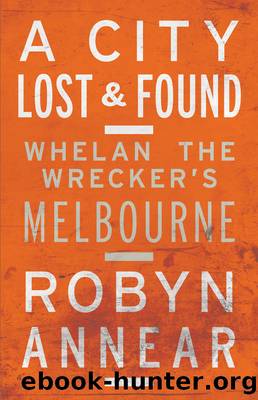A City Lost & Found by Unknown

Author:Unknown
Language: eng
Format: epub
ISBN: 0000000000000
Published: 2021-11-05T09:01:23+00:00
1. Fish Market
2. Western Market
3. Eastern Market
4. Old White Hart Hotel
5. Royal Mail Hotel
CHAPTER 10
You Never Know What Might be Under It
Fish Market ~ Western Market ~ Eastern Market ~ Old White Hart Hotel ~ Royal Mail Hotel
Not fifty years ago, ten acres of central Melbourne was occupied by marketplaces. In a city where ground had never been set aside for a public square, its markets had, over the years, sometimes served as the next-best thing. But in post-Olympics Melbourne, their day was done â had been, really, a long time since.
Whelan the Wrecker hung its signs â Is Here and Was Here â on two of the cityâs markets during 1959â60, concurrent with the CML demolition. The third theyâd knocked down a year earlier. Two of the three had existed for nearly as long as Melbourne, ranking them either as âpriceless heritage from Colonial daysâ or âa complete anachronismâ â take your pick. But in the progress-hungry Sputnik years and with the markets inarguably redundant, the city councilâs refashioning of its market reserves created âan opportunity possessed by few other of the worldâs large cities for large-scale down-town developmentâ.
The Fish Market was the last-built and the first to fall. In truth, it had been sinking and cracking for years, owing to the silty ground in which its foundations were sunk. The eccentric pile of buildings collectively known as the Fish Market was constructed in Flinders Street in 1891â92 â the last gasp of the land boom. It stretched all the way from King to Spencer Street and back towards the river, on ground that had formed the apron of the old Coleâs and Raleighâs wharves and was now (and is still) bisected by the rail viaduct connecting Flinders and Spencer street stations.
The Fish Market was an oddity for Melbourne: a building out of square. In cities like Sydney, which took shape according to their own geometries, buildings were commonly given curved facades to fit the streets on which they stood. Not so in central Melbourne, where buildings conformed to the dead-straight lines of Hoddleâs grid. What made the Fish Market odder was that it wasnât its front that curved, but its back â the rear of its main building mimicked the bend of the viaduct.
The Fish Marketâs front might have been as flat as that of any Melbourne building, but straight it was not. This was a municipal market, remember, selling and storing for export such commonplaces as poultry, rabbits and butter, besides fish. Yet, to a modern eye, its Flinders Street frontage would suggest a far more glamorous, and certainly less noisome, civic function. Two hundred metres long and three red-brick storeys high, the Fish Market was sprigged with basilisk-spired turrets and a Westminsterish clock-tower over its arched main entrance, and was as grand and garish a public building as could be wished for.
Download
This site does not store any files on its server. We only index and link to content provided by other sites. Please contact the content providers to delete copyright contents if any and email us, we'll remove relevant links or contents immediately.
| Central Asia | Southeast Asia |
| China | Hong Kong |
| India | Japan |
| Korea | Pakistan |
| Philippines | Russia |
The Sympathizer by Viet Thanh Nguyen(4308)
The Rape of Nanking by Iris Chang(4140)
World without end by Ken Follett(3432)
Ants Among Elephants by Sujatha Gidla(3417)
Blood and Sand by Alex Von Tunzelmann(3140)
Japanese Design by Patricia J. Graham(3112)
City of Djinns: a year in Delhi by William Dalrymple(2516)
The Queen of Nothing by Holly Black(2499)
Foreign Devils on the Silk Road: The Search for the Lost Treasures of Central Asia by Peter Hopkirk(2434)
India's Ancient Past by R.S. Sharma(2417)
Inglorious Empire by Shashi Tharoor(2396)
Tokyo by Rob Goss(2390)
In Order to Live: A North Korean Girl's Journey to Freedom by Yeonmi Park(2348)
India's biggest cover-up by Dhar Anuj(2319)
Tokyo Geek's Guide: Manga, Anime, Gaming, Cosplay, Toys, Idols & More - The Ultimate Guide to Japan's Otaku Culture by Simone Gianni(2316)
The Great Game: On Secret Service in High Asia by Peter Hopkirk(2305)
Goodbye Madame Butterfly(2209)
Batik by Rudolf Smend(2128)
Living Silence in Burma by Christina Fink(2038)
